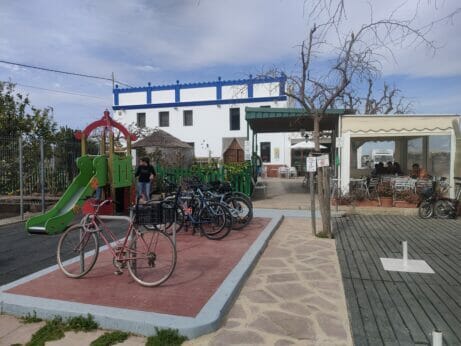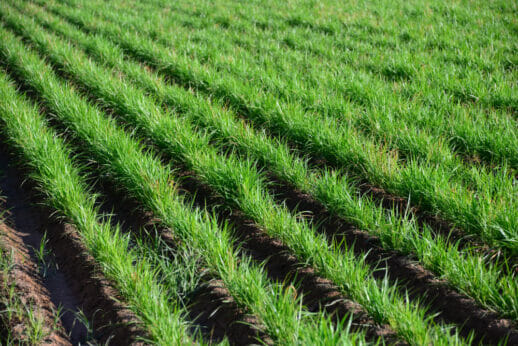The traditional Spanish drink is still beloved in Valencia, but it’s getting harder to produce. Now, farmers are contending with less water and lower yields in the quest to quench their thirst.

It’s a hot day, and Horchatería Vida in Alboraya, Spain is a hive of activity. With the Via Verde Xurra bike lane, which connects the city of Valencia to the Horta Nord, in front of the entrance, the place is full of thirsty cyclists. As the customers dunk fartons—long brioche-type pastries—into their horchata, they can also look out onto the fields where the tiger nuts are grown. Alboraya is considered the birthplace of horchata and customers still flock to local businesses like this.

Photography courtesy of author.
In operation since 2013, Horchatería Vida is the brainchild of Vicenta Bertomeu Dominica (68), who started the business to ensure a consistent market for the tiger nuts grown by her husband, Vicente Alonso Esteve (74). What began as a single stall outside of their 1880 farmhouse—where Esteve grew up—has evolved into a full-service restaurant.
Terracotta in color, tiger nuts owe their name to the raised stripes on their surface. These sweet, fibrous tubers, which are high in magnesium, potassium and vitamins C and E, have been heralded as a superfood, but they’ve long been popular in Valencia.
Every year, Vicente uses half of his two hectares of land to produce tiger nuts, while the other half lies fallow for a year. When harvested, the total weight of the tubers is around 1,300 kilograms (2,870 pounds), but after they have been washed and dried and debris is removed from the haul, there are about 600 kg (1,320 lb) of usable root vegetables.

Chufa plants in the field. Photography by Shutterstock.
In recent years, Vicente has noticed diminishing harvests. “My initial harvest used to weigh 1,700 kg (3,750 pounds), but that’s no longer the case,” he says. Vicente suspects that the treated water he now uses in combination with the cleaner, but costlier river water, which has to be pumped out of the river and transported to his farm, could be detrimental to his yield. “The treated water is free, but I don’t like using it, because there are contaminants in it that are not good for the harvest,” he says. “The population of Valencia has grown, and there’s less drinking water available for agriculture. The system forced me to change what I was doing.” Increased temperatures are also causing tiger nut plants to die earlier, but little can be done to adapt to these conditions other than watering the crop more regularly, according to Vicente.
Local tiger nuts have also been suffering from xufa yellow dwarf virus. Following research by Instituto Valenciano de Investigaciones Agrarias, Universidad Católica de Valencia San Vicente Mártir and Universitat Politècnica de València, experts have recommended the quarantine of imported tiger nuts from Africa, as this is where the virus is thought to have come from. The Consejo Regulador Denominación de Origen Chufa de Valencia offers tiger nut certification to confirm the Valencian origin.
The life cycle of tiger nut plants is six to seven months. Vicente sows the tiger nuts with a mechanical seeding machine in April, and it typically takes 10 days for them to germinate. In mid-November, once the plant has dried out, it is burned and the harvest begins. Vicente doesn’t have any employees, but every year he contracts a man with a harvester to extract the tubers. “We use machinery to harvest four or five bushels a day,” says Vicente.
The tiger nuts are then washed and laid to dry in warehouses from December to April. There, they are moved daily to reduce their water content and concentrate their sugars, eliminating the risk of fermentation. “In May, we begin using the tiger nuts from the previous year,” says Vicenta. “Freshly picked tiger nuts aren’t sweet. They mature when dried.”

Photography courtesy of author.
Vicenta makes her horchata in a processing facility off-site, as the couple doesn’t have the funds to invest in the expensive machinery required. The dried tiger nuts are soaked for around 12 hours before being turned into a paste, which is then squeezed and sieved to separate the pulp from the juice. Water is then added to the tiger nut juice, and sugar is an optional sweetener. “From one kilo of dried tiger nuts, you can make five to six liters of horchata,” says Vicente. As no preservatives are used, the shelf life is just two to three days.
Vicente also notes the increased number of abandoned fields in the area, something that is becoming more and more common in their area. Vicente’s family has been farming for more than 100 years, and they have built a loyal customer base since opening their horchatería. Despite the popularity of the business, the future of both the horchatería and Vicente’s farm is uncertain. The couple’s three children currently have no concrete plans to continue the business, but Vicente hopes that at least one of his children will grow tiger nuts in the future. “Sowing the tubers and then finding someone with a harvester to collect them isn’t too much work, so perhaps they’ll keep it up.”
Most in this country is made with rice, in fact I make a gringo horchata. I make it wrong, but it taste the same.